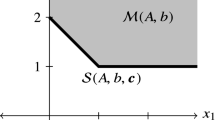Abstract
Through key examples and constructs, exact and approximate, complexity, computability, and solution of linear programming systems are reexamined in the light of Khachian's new notion of (approximate) solution. Algorithms, basic theorems, and alternate representations are reviewed. It is shown that the Klee-Minty example hasnever been exponential for (exact) adjacent extreme point algorithms and that the Balinski-Gomory (exact) algorithm continues to be polynomial in cases where (approximate) ellipsoidal “centered-cutoff” algorithms (Levin, Shor, Khachian, Gacs-Lovasz) are exponential. By “model approximation,” both the Klee-Minty and the new J. Clausen examples are shown to be trivial (explicitly solvable) interval programming problems. A new notion of computable (approximate) solution is proposed together with ana priori regularization for linear programming systems. New polyhedral “constraint contraction” algorithms are proposed for approximate solution and the relevance of interval programming for good starts or exact solution is brought forth. It is concluded from all this that the “imposed problem ignorance” of past complexity research is deleterious to research progress on “computability” or “efficiency of computation.”
Similar content being viewed by others
References
R. Armstrong, A. Charnes, and F. Phillips, “Page cuts for integer interval linear programming,”Discrete Appl. Math. 1:1–14 (1979).
M. L. Balinski and R. E. Gomory, “A primal method for the assignment and transportation problems,”Manage. Sci. 10:578–594 (1964).
A. Ben-Israel and A. Charnes, “An explicit solution of a class of linear programming problems,”Oper. Res. 16:1166–1175 (1968).
A. Charnes, “Optimality and degeneracy in linear programming,”Econometrica 20:160–170 (1952).
A. Charnes and W. W. Cooper,Management Models and Industrial Applications of Linear Programming, Vol. I and II (Wiley, New York, 1961).
A. Charnes, D. Granot, and F. Granot, “A primal algorithm for interval linear programming problems,”Linear Algebra and Its Appl. 17:65–78 (1977).
A. Charnes, F. Granot, and F. Phillips, “An algorithm for solving interval linear programming problems,”Oper. Res. 25:688–695 (July–August 1977).
A. Charnes and K. Kortanek, “An Opposite Sign Algorithm for ‘Purification’ to an Extreme Point Solution,” ONR Research Report No. 84, Systems Research Group, Northwestern University (June 1963).
A. Charnes and C. E. Lemke, “A modified simplex method for control of roundoff error in linear programming,”Proceedings of the ACM, Pittsburgh (May 2–3, 1952), pp. 97–98.
A. Charnes, W. W. Cooper, and G. Thompson, “Some properties of redundant constraints and extraneous variables in direct and dual linear programming problems,”Oper. Res. 10:711–723 (1962).
A. Charnes, K. Kortanek, and W. Raike, “Extreme Point Solutions in Mathematical Programming: An Opposite Sign Algorithm,” Systems Research Memorandum No. 129, Systems Research Group, Northwestern University (June 1963).
A. Charnes, D. Karney, D. Klingman, and J. Stutz, “Past, present and future of large scale transshipment computer codes and applications,”Comprs. and Oper. Res. J. 2:71–81 (1975).
U. Eckhardt, “Representation of convex sets,” inExtremal Methods and Systems Analysis, A. V. Fiacco and K. O. Kortanek, Eds. (Springer-Verlag, Berlin, 1980), pp. 374–384.
P. Gacs and L. Lovasz, “Khachian's Algorithm for Linear Programming,” Working Paper, Computer Science Department, Stanford University (Fall 1979).
R. Jeroslow, “Trivial integer programs unsolvable by branch and bound,”Math. Programming 6:105–109 (1974).
L. G. Khachian, “A polynomial algorithm in linear programming,”Soviet Math. Doklady 20:191–194 (1979).
V. Klee and G. J. Minty, “How good is the simplex algorithm?” inInequalities III, O. Shisha, Ed., (Academic Press, New York, 1971), pp. 159–175.
B. Korte, D. Hausmann, and R. Kannan, “Exponentielle untere Komplexitätsschranken für eine Klasse von Knapsackproblemen,”Oper. Res. Verfahren 32:143–147 (1979).
A. Yu. Levin, “An algorithm for the minimization of convex functions,”Dokl. Akad. Nauk SSSR 160(6) (1965).
P. D. Roberts and A. Ben-Israel, “A suboptimization method for interval linear programming: A new method for linear programming,”Linear Algebra and Its Appl. 3:383–405 (1970).
N. Z. Shor, “On the rate of convergence of the generalized gradient methods,”Kibernetika, No. 3 (1968).
N. Z. Shor, “The use of the operation of space dilatation in the minimization of convex functions,”Kibernetika, No. 1, 6–12 (1970).
N. Z. Shor, “Generalized gradient methods for the minimization of nonsmooth functions and the application in mathematical programming” (survey),Ekonom. Mat. Metody 12(2) (1976).
N. Z. Shor, “Cut-off Method with space extension in convex programming problems,”Kibernetika, No. 1, 94–95 (Jan.–Feb. 1977).
N. Z. Shor and V. I. Biletskii, “The method of space dilatation to accelerate convergence in gully-type problems,”Optimal Decision Theory 2 (1969) (Kiev).
Author information
Authors and Affiliations
Additional information
This research was partly supported by Project NR047-071, ONR Contract N00014-80-C-0242, and Project NR047-021, ONR Contract N00014-75-C-0569, with the Center for Cybernetic Studies, The University of Texas at Austin.
Rights and permissions
About this article
Cite this article
Charnes, A., Cooper, W.W., Duffuaa, S. et al. Complexity and computability of solutions to linear programming systems. International Journal of Computer and Information Sciences 9, 483–506 (1980). https://doi.org/10.1007/BF01417939
Received:
Revised:
Issue Date:
DOI: https://doi.org/10.1007/BF01417939




